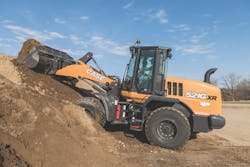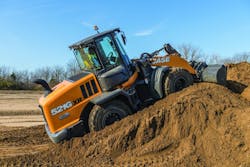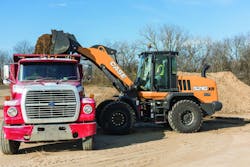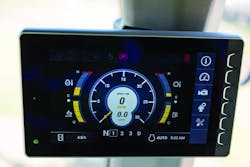It was an unseasonably warm early winter day in Bartonville, Ill., as Independent Union of Operating Engineers Local 649 instructors Todd Shreves and Matt Ulm took turns pushing a Case 521G XR (extended reach) wheel loader through a number of loading, roading, and maneuvering tasks.
The way they attacked piles of both loose sand and packed dirt, one almost wished for bad weather—and bad traction—but the equipment veterans made up for the clean conditions with their own impromptu tests, such as backing steeply up piles with a full bucket and executing fast figure eights in reverse while dragging the bucket.
More on their individual feats a little later.
Introduced late in 2016, the 521G was one of seven new G Series wheel loaders that brought the entire line (141 to 347 horsepower, 2.1- to 6.25-cubic-yard buckets) to Tier 4-F using SCR technology.
“The only necessary action for emissions is adding the DEF,” says Jeff Feldkamp, the Case product specialist accompanying the loader for the test. “[Any other measures with DEF] are taken care of automatically within the machine. In the winter, DEF is going to freeze, so engine coolant is circulated through the DEF tank through a worm. That’s going to thaw that DEF out and after it’s thawed, then it’s going to start injecting. When you shut the machine off, you’re going to hear an evacuation pump that will evacuate all the DEF out of the SCR chambers and lines, back into the DEF tank so it doesn’t freeze and break lines.
“We’ve got time-delayed relays and a smart fuse box that keeps that whole system energized until that task is done.”
All G models have the conventional Z-bar linkage option, and the XR linkage option that Local 649 tested, available. The 521G through 721G also offer an XT (tool carrier) version. In general, Feldkamp says XR buyers will get 6 to 8 inches of extra hinge pin height, making the 521G achieve the hinge pin height of the regular Z-bar 621G. “You gain a little bit of extra reach without going to the next size up,” he says. “XR machines are becoming more popular as customers are trying to stretch their units further to get that production cost just right.”
In going from the F Series to G Series, perhaps the biggest change Case executed was the completely redesigned cab and operator environment. It was a cab amenity that first attracted Ulm’s attention.
“That was one of the first things I noticed climbing up there; that nice, clean, comfy seat,” Ulm says. “When you’re sitting in one all day long, that seat makes a big difference. I found the switch for the heat in the seat, then took it for a quick ‘hot lap’ coming right off the trailer and really enjoyed it.”
The seat in this 521G was the optional cloth-covered, heated air-suspension seat, one upgrade over the fully adjustable suspension seat that comes with the base 521G model. A premium leather-trimmed heated air seat with active suspension is also available.
Another noticeable feature was the cab’s curved glass and relative lack of wide posts. “We’ve spent a ton of engineering and development coming up with the operator environment,” Feldkamp says. “The elimination of straight, flat panels gives a much better visibility to working surfaces. The curved glass gives it a more automotive-style quality.”
An automobile-like appearance to the operator is no accident. Doug Ochsner, a Case territory sales manager along to observe the test, sums up the company’s G Series cab strategy. “If it’s in their diesel pickup truck, they want it in their construction equipment,” he says.
In addition to improved views to the working surface, the sightline to the coupler has also been improved. This loader’s 2.1-cubic-yard bucket was attached with a JRB-style quick coupler, which is released from the cab with a push of a button.
Both operators made it a personal, unprompted point to stop their loading tasks to uncouple and couple the bucket. “One of the things I like about the coupling and uncoupling is the visibility,” Ulm says. “You can see those bucket pins go in and out. A lot of times on some of these machines, there’s not the visibility down that boom, down that front, to be able to see those pins actually couple in and out of the bucket. A lot of them you have to get out and visually inspect as to whether they’re in. This one, all you have to do is boom up just a little bit and you can see right where that pin goes in and out.”
Shreves was also impressed. “The visibility is awesome, and that’s what I wanted to check out when I pulled the pins for the bucket. Sure, we have the screen to tell us, and also the buttons here, red and green, but that being said, I wanted a visual inspection on that pin. And I can see it just leaning forward, so it’s incredible. Kudos to the ‘sight’ engineers there,” Shreves jokes.
A visual indication of pin status is one of the many things found on the machine’s ‘nerve center,’ the 8-inch color LCD monitor, another major new feature on the 521 and the G Series. “[The indicator] works real well on the screen,” Shreves says. “It actually tells you when the bucket is coupled or uncoupled. As I pushed that bucket, I watched the screen. I do like that feature.”
For buckets, and other attachments, auxiliary hydraulics are optional with a control preference (joystick or single-axis levers) and three and four functions. With auxiliary hydraulics, the hydraulic flow is controlled from the cab at all times, decreased or increased with a push of a button via the monitor.
“You can adjust the auxiliary hydraulic flow to the front couplers by dialing in what’s necessary for that attachment without expensive relief valves and other hydraulic components,” Feldkamp notes.
The monitor is located on the machine’s right post and is where the operator will find readouts from the typical operating gauges, rpm, gear selection, and more. It is customizable depending on the displays desired.
This particular unit was equipped with an optional rearview camera, also viewable on the monitor. Operators can choose whether or not to see guidelines superimposed on the image for a better indication of the travel path and the proximity to objects shown.
The monitor is also used to make adjustments on the four different horsepower settings for the 521G’s engine (Max, Standard, Economy, Auto), as well as diagnostics, trip functions, and fuel usage stats.
For the G Series, Case eliminated thousands of feet of wiring, Feldkamp says, by going to a membrane switch (instead of rocker switches) to control advance functions such as return-to-height, return-to-work, and return-to-dig. “In the past, each switch would have had five wires feeding it,” Feldkamp says. “Now there are five wires to the whole panel itself.”
Shreves gave the monitor and switches a thumbs-up. “Somebody’s done some good thinking here,” he says. “It’s operator friendly, and everything you need is there. I picked things up quickly after five minutes in the cab—simple is good for operators.”
Performance-wise, both operators put their own flair into testing. Ulm made sure to find ditches to traverse.
“I wanted to check out the stability, that was the main reason I went through the ditch with a full bucket,” Ulm says. “I wanted to see how it maneuvered going down through that ditch. I was very impressed with the manueverability. I was also impressed with it at higher speed and how the machine roaded with a full bucket and the ride control. At one point, I turned it off just to see the difference, but they definitely have that part of the machine figured out when it comes to roading.”
The optional ride control feature comes on automatically when the loader reaches 3 mph, but can be turned off any time. “There are several applications where you’d be roading a load of sand or gravel, maybe even in occupied traffic,” Ulm says. “I always like to see if a machine is going to have any spillage or if I can get it up into those higher gears to get around the job site without spilling.”
After a stretch of roading, Shreves pulled the 521G away from the haul road and the material piles into a wide-open space where he began to ad lib fast figure eight moves, in reverse, with the loader bucket sliding on the ground.
“I wanted to see how sharp it would turn [doing the reverse figure eights] and I wanted to see what it would feel like in the cab when it articulated quickly, turning to the left and right. It stayed pretty stable,” Shreves says.
Shreves also backed up a fairly steep sand pile, with a full bucket, and stopped. It looked like he may have been testing the 521G’s generous rear departure angle (30 degrees) for clearance, but Ulm saw it differently. “He’s backing up a hill with a full bucket because it always gives you that pucker factor of how’s the machine going to do coming back up out of a ditch?” Ulm says. “Are the rear wheels going to get light? Is it going to hold? But the machine is well balanced and it did fine.”
“The traction seemed pretty good, pretty stable,” Shreves says. “I was pretty pleased with walking up on the sand there, what it would do. It didn’t move.”
As for attacking piles in the forward gear, Ulm and Shreves gave the loader high marks. “When I got in the harder material, I liked the way it grabbed and it had real good traction to dig in and get a full bucket,” Ulm says. “I think that would help the efficiency of loading material that had been sitting for a while. I think back to a time when I was loading asphalt millings; road millings tend to get hard after they bake for a while in the sun. I think the machine would be good for a situation like that with its traction, and plenty of horsepower to dig.”
Shreves was also happy with the horsepower. “It seemed like there was plenty of horsepower as well as traction, and it seems like the weight is well distributed,” he said. “I had a heck of a time trying to get the tires to spin. Getting that horsepower to meet that ground is huge.”
The 521 comes standard with limited-slip axles that transfer torque “from the slipping tire to the gripping tire.” Going up in size (621G through 921G) allows the option of a 5-speed PowerShift transmission with lock-up torque converter.
Ulm liked not only the traction, but also the automated bucket controls combined with the XR configuration’s reach. “I’d use the return-to-dig loading trucks or charging into asphalt, even pushing up piles and climbing the pile a little bit,” he says. “A lot of the time you may be piling up material because you’re limited as to space. You have to stack your rock, sand, or gravel. I wanted to see when I was climbing the pile how it did when I was trying to stack that material as tall as possible with the XR boom. It did a fine job.”
“I think it’s a pretty good little machine,” Shreves says.
About the Author
Frank Raczon
Raczon’s writing career spans nearly 25 years, including magazine publishing and public relations work with some of the industry’s major equipment manufacturers. He has won numerous awards in his career, including nods from the Construction Writers Association, the Association of Equipment Manufacturers, and BtoB magazine. He is responsible for the magazine's Buying Files.




